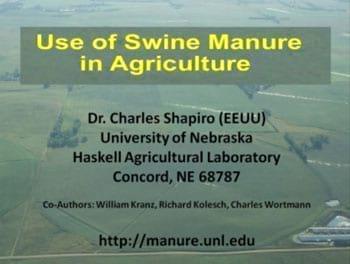Remove Solids in Pig Manure Prior to Aeration
Published: July 31, 2008
Source : University of Minnesota Extension publication
The recent research conducted at the University of Minnesota Southern Research and Outreach Center at Waseca has indicated that the manure solids content plays an important role in affecting oxygen transfer into the treated liquid. The study used fresh swine manure with four solids contents, i.e., 0.5, 1.0, 2.0, and 4.0%, to investigate several parameters reflecting the efficiency of aeration systems. The first parameter is the time needed to reach oxygen saturation concentration. The results show that it will take 15, 20, 40, and 60 minutes, respectively, to reach saturation for the four solids content, indicating that longer aeration time is needed for manure with higher solids content. The oxygen holding capacity of aerated liquid with different solids levels is also examined with findings presented in Figure 1. When aeration stops after the dissolved oxygen (DO) in the liquid under aeration has reached saturation, it is observed that the rate at which the DO decreases is in accordance with the solids content in the manure. For manures with 4.0% and 2.0% total solids content, the DO concentration nears zero within about 30 and 60 minutes after aeration stops, respectively. However, for the two liquids with lower solids content of 0.5 and 1.0%, only slight decreases in DO concentration are observed during the same time period. These findings clearly demonstrate that removing solids from manure before aeration holds potential for greatly lowering aeration time, thus saving energy.

Figure 1. Changes in oxygen concentration in the slurry after aeration stopped
One other important parameter examined in this study is the overall oxygen transfer coefficient (kLa). When the amount of manure solids increases from 0.5 to 4.0%, it leads to a reduction in oxygen transfer coefficient from roughly 0.59 min-1 to 0.15 min-1 (Figure 2). This means that the oxygen transfer rate in manure at 4.0% total solids level is reduced to about a quarter of the value in manure at 0.5% total solids level. Consequently, the energy consumption for the former will be nearly as four times as that for the latter in order to achieve the same DO level in the treated liquid. Also, according to statistical analysis, there is insignificant difference between the values of kLa for total solids groups ranging from 0.5 to 1.0% and from 2.0 to 4.0%, while the difference is significant between groups. It thus follows that the more solids are contained in manure, the worse is the aeration efficiency, which subsequently drives up the aeration cost because of the increased running time needed. Therefore, in practice, it is highly recommended that the solids level in manure be reduced prior to aeration treatment to help reduce aeration cost.

Figure 2. Changes in oxygen transfer coefficient kLa with respect to changes in manure total solids content
By Jun Zhu, University of Minnesota Extension Engineer
University of Minnesota Extension Communication and Educational Technology Services
Source
University of Minnesota Extension publicationRelated topics
Recommend
Comment
Share

Would you like to discuss another topic? Create a new post to engage with experts in the community.





